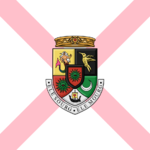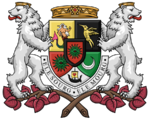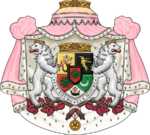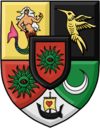Monarchy of Sabia and Verona
| King of the Valtirians | |
|---|---|
| rai valtirgeninnán | |
 | |
| Incumbent | |
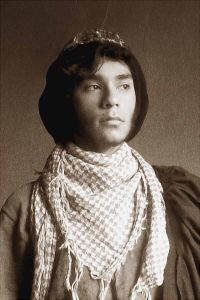 | |
| Tarik since 23 August 2015 | |
| Details | |
| Style | His Majesty |
| First monarch | Ciprian |
| Formation | 20 October 2012 |
| Appointer | Sabioveronese people |
| Sabia and Verona |
| This article is part of the series |
| Politics and government of Sabia and Verona |
| Constitution |
|---|
| Supreme Court |
| Electoral Commission |
| Foreign relations |
| History |
Sabia and Verona is a constitutional, parliamentary and elective monarchy, headed by the King or Queen. As an elective monarchy, the Monarch of Sabia and Verona is chosen by the Sabioveronese people. Sabia and Verona was founded as an overseas territory of Juclandia, and so the first king of Sabia and Verona was Ciprian of Juclandia. The present reigning King of Sabia and Verona is Tarik of Karjasari, who holds the title of "King of the Valtirians" (rai valtirgeninnán), since 23 August 2015.
By constitutional law, only human citizens of Sabia and Verona can be chosen as King or Queen; plush toys are barred from serving as Monarch. Those who are eligible to become King or Queen of the Valtirians are inscribed in the Book of Electors, a tome edited exclusively by the reigning Monarch.
History
The title of "King of Sabia and Verona" had belonged to the King of Juclandia since 20 October 2012, when Sabia and Verona was founded as an overseas territory of Juclandia. In late 2012, the Three King Rebellion sparked with three different Sabioveronese leaders claiming themselves Kings of different parts of Sabia and Verona. However, the insurgence was quickly put out by the government of Napoléon Bleuberrie. In 2014, Juclandia underwent a series of changes and Sabia and Verona became a province of the Federal Union of Juclandian Lands, allowing its government system to be changed. The Courts of Sabia and Verona voted in favour of crowning a new monarch for Sabia and Verona only, and Isadora Annenak, who had previously served as Governor was chosen by the federal citizenry.[1]
Lycem, the neighbouring country to the east, became part of Sabia and Verona on 23 February 2014 as well, and the official title of Isadora became "Queen of All Sabia, Verona and Lycem". Isadora's coronation, scheduled due 23 February 2014, was postponed due to the heated protests and conflicts affecting the region at the time. Isadora was crowned on 27 April 2014 in the town of Ejido. In October 2014, as the result of the adoption of a series of policies aimed at solidifying the national identity of Sabia and Verona, the Isadora's title was once again ammended to "Queen of the Valtirians", reflecting the unifying character of the Monarchy. The position of the Monarch was also merged with that of the High Priest of the Pahun, to reflect the newly acquired status of state religion by the Church of the Pahun.[2]
In 2015, faced by the imminent execution of the Haronos Plan, Isadora abdicated the Crown as she would be unable to move alongside the government to the new capital of the Nation, Alios. Among the possible candidates named in the Book of Electors, only former Governor Tarik Karjasari was eligible as he met all the requirements to assume the task.[3] He was named and crowned as King of the Valtirians on the same day, 23 August 2015.[4] Tarik has ruled since, and on 24 February 2017, he became the longest-reigning monarch of Sabia and Verona and the whole Valtir Sector.
Authority
The exact authority and the degree of political power of the Sabioveronese monarch has varied from reign to reign. During the Jucarestian era, when the monarch of Sabia and Verona was the King of Juclandia, the monarchy was a vastly symbolic institution and the King rarely participated in Sabioveronese politics. This is mostly due to the geographic isolation of Sabia and Verona from the rest of Juclandia. Most of the King's duties were carried out by the Governor, who was appointed by the King himself to represent the Crown in Sabia and Verona. Governors of this era held most of the power in practice.
After the establishment of the Federation and the coronation of Queen Isadora, a new constitution was adopted and the position of the new King or Queen of the Valtirians became more relevant to the internal political procedures of the Kingdom. The monarch now had say in political stalemates in the Courts, as well as the power to veto certain legislative and judicial acts of the Courts. Furthermore, the Crown could grant honours to Sabioveronese and foreign citizens, such as that of the Order of the Baphomet, the Order of the Needle and the Order of the Hummingbird, a position formerly held by the Prime Minister and the Governor. The extent of the monarch's political power was further increased by the 2015 constitution adopted after the coronation of King Tarik, in which the Crown became one of the three components of the Executive Sounos alongside the PM and the Royal Council of State. The King is now the sole political representative of the federal citizenry of Sabia and Verona, as they are the only federal citizen legally allowed to be in the government.
Regalia

The Sabioveronese Regalia are the items used to represent the Monarch's rule over the nation, and are intended to be worn by the Monarch in ceremonial occasions such as crownings and bestowals of honours. The entire regalia was made with 18 gauge copper wire and 20 gauge scarlet-coloured aluminium wire, both common traits in Sabioveronese jewelry. Queen Isadora's regalia is composed of the Crown of Saint Jason Momoa, the Orb of Plenty and the Sceptre of Concord.
The Crown of Saint Jason Momoa (originally known as the Crown of Equity) was made first, commissioned by the Sabioveronese Government in the name of the to-be-Queen Isadora. It's composed of two reinforced rings made of 18 gauge copper wire, arranged in the form of a tiara and ornamented with 20 gauge scarlet-tainted aluminium wire. The only jewel of the crown is a salmon-coloured glass sphere, which was initially part of a set given as a present to the Royal Household of Lycem in 2013. The set contained a sky blue charm and two salmon-coloured charms, all three made of glass. The other salmon-coloured charm is used in the Orb of Plenty, while the sky blue charm is part of the Royal Arks' Collection. The Sceptre of Concord is a 27 cm. (10'5 inch.) hollow staff composed of an intricate pattern made with equal proportions of copper and aluminium wire. At the head of the Sceptre rests a pinecone originally picked by the young Queen herself from the Sournêliádin Gardens, to the southeast of Sabia. The pinecone is a symbol of peace and concord in Sabioveronese tradition.
Although the regalia is no longer in possession of the monarchy, the Crown of Saint Jason Momoa and the other attributes granted to Queen Isadora remain as symbols of the Sabioveronese monarchy today; the Crown is still represented in the royal arms.
Full titles
The present form of the royal title was imposed in 2017 by King Tarik. It considerably shortened the full title, and included the peerage title of the Monarch, which had been excluded from the royal title due to the elective nature of the Sabioveronese monarchy.[5]
- His Plushen Majesty, By the Will of his People, King of the Valtirians, Defender of the Avendrá, Voice of the Plushies, Duke of Evra, Lord Maestre of the Imperial Order of the Baphomet, Maestre of the Order of the Needle, Senior Marshal of the Order of the Hummingbird.
- (in Sabian) barbunolann, sunideroti geninnán, rai valtirgeninnán, senna avendrannán, tai bunarinn, aibarág evrañ, aiakrí airraidaibokinnán babametoná, akrí daibokinnán varagonnán, aegroakrí daibokinnán sanaħasonnán.
From 2014 to 2017, the full royal title of the Sabioveronese monarch was: By the Grace of the Pahun and the Will of his People, King of the Valtirians, King of Sabia and Verona, King of Lycem and the Eastern Realms, Protector of the Flame, High Priest of the Pahun, Shäi of the Pashqari, Prince of the Sunrise and the Sunset, Protector of the South.
The first autonomous monarch of Sabia and Verona, Isadora of Annenak, was originally crowned with the title of "Queen of All Sabia, Verona, and Lycem". In October 2014 the "All Sabia, Verona, and Lycem" part was replaced with "...the Valtirians", making Sabia and Verona a popular monarchy. The title of "Prince of the Sunrise and the Sunset" was originally given to Isadora as "Princess of the Sunset", and it refered to the position of Sabia and Verona to the west of Lycem, while the title itself is of Lycene origin. With the annexation of Lycem into Sabia and Verona, the title became "... of the Sunrise and the Sunset", to symbolize the East (Lycem) and the West (Sabia and Verona). The title "Protector of the South" was created with the coronation of King Tarik, who although crowned in Salisse, would continue his rule from the new capital of Alios. Additionally, Tarik's predecessor, Isadora, was given the honorary title of "Protector of the North". Most of these titles were dropped by the 2017 Royal Decree concerning the Monarch's full titles.[5]
Arms and standards
The Sabioveronese Monarch is represented by their coat of arms (raimurgodai), which is also used as the Kingdom's official arms. The present Royal Arms are those of King Tarik. The Royal Standard is the official banner of the Monarch, and consists of the lesser Royal Arms on an eerie black field.
-
Royal Standard of the Sabioveronese Monarch -
Middle arms of the Sabioveronese Monarch -
Greater arms of the Sabioveronse Monarch
The present Royal Arms are described as follows:
- Quarterly, first quarter Or a Valtirian rama Proper (for Sabia), second quarter Sable, a hummingbird rousant Or (for Verona), third quarter Gules, a sun Vert charged with an eye Sable with a pupil of the same tincture and an iris of the field (for Lycem), fourth quarter Vert, a crescent montant Argent (for Gonn), enté en point Argent a sailboat Sable with a single sail set Or charged with a heart Gules (for Alios), overall an escutcheon Gules bordure Sable, a sun Vert bearing an eye Sable with a pupil of the same tincture and an iris of the field (for the regnant House of Karjasari), the whole surrounded by a ribbon Argent charged with the Motto "ele sourg • ele mourg"; for a Crest, the Royal Crown Proper; for Supporters, two polar bears rampant regardant Proper crowned as the Crest, standing upon two crossed smoketree spurge branches all Proper; Mantling Rose lined Ermine, topped by a pavillion of the same crowned as the Crest.
List of monarchs
| No. | Name Sabian birth |
Portrait | Arms | Reign | House Branch |
Title Sabian | ||
|---|---|---|---|---|---|---|---|---|
| Reign start | Reign end | Reign duration | ||||||
| 1 | Ciprian kibrian sorinn born 1997 |
 |
 |
20 October 2012 |
23 February 2014 |
1 year, 4 months, 3 days | Juclandia Juclandia |
King of Sabia and Verona rai sabiann i veronann |
| 2 | Isadora isadora isadoravái born 1999 |
 |
 |
23 February 2014 |
23 August 2015 |
1 year, 6 months | Annenak Annenak Itešar |
Queen of the Valtirians rai valtirgeninnán |
| 3 | Tarik tarik kodavái born 1999 |
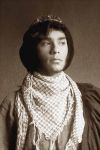 |
 |
23 August 2015 |
present | 9 years, 2 months, 26 days | Karjasari Karjasari Groxi |
King of the Valtirians rai valtirgeninnán |
References
- ↑ Karjasari, Tarik (21 February 2014) "Stefanović: the situation in Venezuela is affecting our internal affairs". The SiV Phonograph. Retrieved 18 December 2019.
- ↑ Karjasari, Tarik (1 October 2014) "Dreaming big: The Aishayerovê and the beginning of a new era". The SiV Phonograph. Retrieved 18 December 2019.
- ↑ Karjasari, Tarik (14 August 2015). The eternal laurels, the peculiar Exodus and the Braganza way. The SiV Phonograph. Retrieved 21 December 2016.
- ↑ Karjasari, Tarik (9 September 2015). "Virny and the Guild take the lead". The SiV Phonograph. Retrieved 18 December 2019.
- ↑ 5.0 5.1 Karjasari, Tarik (3 January 2017). "King releases two royal decrees, modifies royal title, dissolves Order". The SiV Phonograph. Retrieved 18 December 2019.

